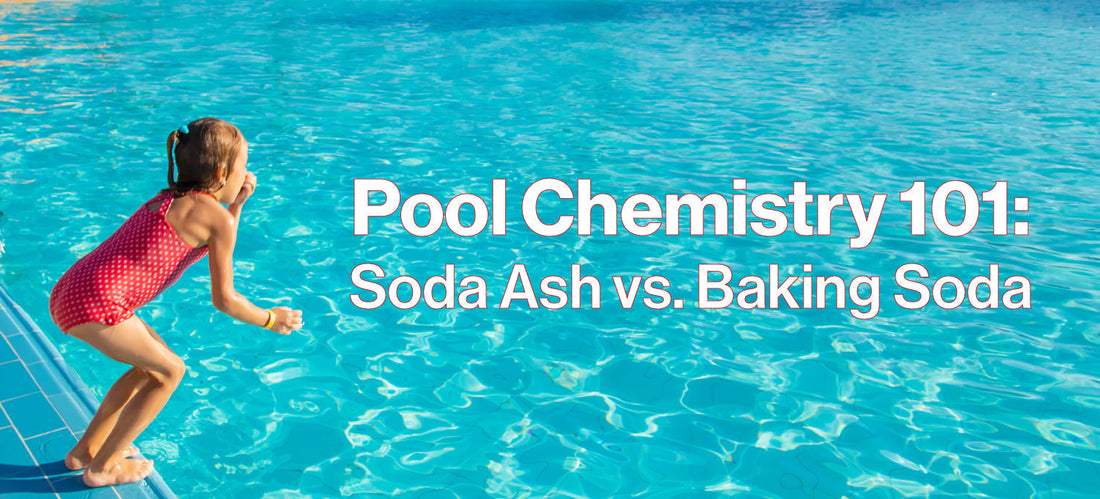
Pool Chemistry 101: Soda Ash vs. Baking Soda – What Your Pool Needs and When
Share
Pool Chemistry 101: Soda Ash vs. Baking Soda – What Your Pool Needs and When
Summer is just around the corner, which means it’s time to make a splash with your pool prep! A big part of maintaining a sparkling, swim-ready pool is balancing the water chemistry. Two common chemicals used for this are sodium carbonate (soda ash) and sodium bicarbonate (baking soda)—but they aren’t the same thing, and knowing when to use each can make a big difference in your pool’s health.
Soda Ash vs. Baking Soda: What’s the Difference?
While both are used to adjust pool water chemistry, they serve different purposes:
- Soda Ash (Sodium Carbonate): Primarily increases alkalinity while having a minor effect on pH.
- Baking Soda (Sodium Bicarbonate): Raises pH and slightly increases alkalinity.
Understanding when to use each can prevent cloudy water, corrosion, or algae growth.
When to Use Baking Soda
If your pH is too low (below 7.2), soda ash is the solution. Low pH can cause eye irritation, damage to pool surfaces, and corrosion of metal parts. Adding baking soda raises the pH, keeping the water comfortable and protecting your pool equipment.
💡 How to Use It:
- Dissolve baking soda in a bucket of water before adding it to the pool.
- Distribute evenly around the pool with the pump running.
- Retest the water after a few hours to ensure the pH is in the ideal range (7.2-7.6).
💧 Standard Dosing: Add 6 oz of baking soda per 10,000 gallons of water to raise pH by about 0.2.
When to Use Soda Ash
If your total alkalinity is too low (below 80 ppm), soda ash helps stabilize it. Proper alkalinity keeps pH from fluctuating wildly, preventing sudden drops or spikes that make maintenance tricky.
💡 How to Use It:
- Sprinkle soda ash directly into the pool water.
- If adding more than 3-4 pounds at once, dissolve it in a bucket of water first to ensure even distribution and prevent cloudiness.
- Allow the pump to circulate it for several hours before retesting.
💧 Standard Dosing: Add 1.5 pounds of soda ash per 10,000 gallons of water to increase alkalinity by about 10 ppm.
How Soda Ash and Baking Soda Affect Chlorine
Chlorine works best when pH and alkalinity are balanced. If pH is too low, chlorine dissipates quickly, making it ineffective. If pH is too high, chlorine becomes less active, meaning you’ll need more to keep the water clean.
- Baking Soda (pH booster) can temporarily make water cloudy, but this clears up as it dissolves.
- Soda Ash (alkalinity booster) can help prevent pH swings, allowing chlorine to work efficiently.
To maximize chlorine effectiveness, aim for a pH of 7.4-7.6 and an alkalinity of 80-120 ppm.
Common Mistakes to Avoid
❌ Adding too much at once – Overcorrection can cause cloudy water. Add chemicals gradually and retest before adding more.
❌ Mixing chemicals directly – Always dissolve soda ash first, and never mix different chemicals together before adding them to the pool.
❌ Neglecting circulation – Always run the pump after adding chemicals to distribute them evenly.
❌ Confusing the two – Using soda ash instead of baking soda won’t effectively raise pH. Likewise, using baking soda when alkalinity is low may not be the best fix.
In Conclusion

By using the right products at the right time, you’ll keep your pool safe, comfortable, and crystal-clear. Now that you know the difference between soda ash and baking soda, you’re ready to dive into summer with confidence! 🌊☀️
Need high-quality soda ash or baking soda? Stock up now and keep your pool in perfect balance!
